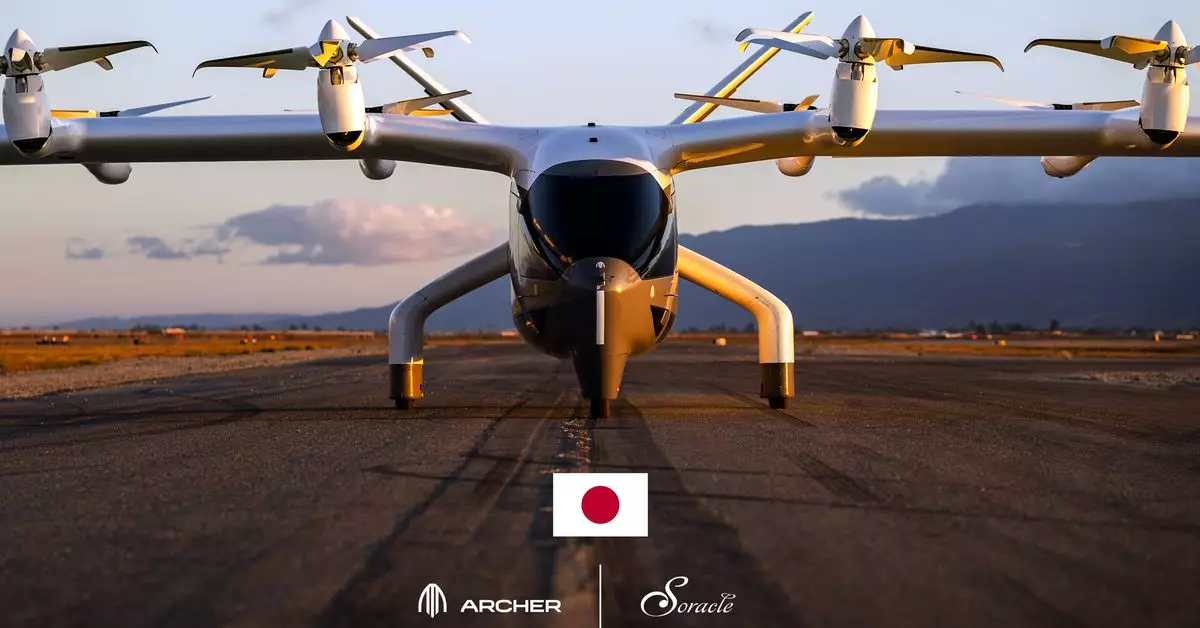In the rapidly evolving landscape of urban transportation, Archer Aviation is emerging as a trailblazer in electric vertical takeoff and landing (eVTOL) technology. With its headquarters in San Jose, California, the company is set to introduce its innovative air taxi service to Japan. Recently, Archer announced a significant agreement to sell 100 of its Midnight aircraft to Soracle, a collaborative initiative between Japan Airlines and Sumitomo Corporation, a deal projected to be worth around $500 million. This bold move signifies not just a commercial partnership but a strategic expansion into a market ripe for transformative air mobility solutions.
The Midnight Aircraft: A Technological Milestone
At the heart of Archer’s vision is the Midnight aircraft, a sophisticated four-seat electric vehicle designed for short-range urban air travel. With a striking design that merges drone functionality with helicopter agility, Midnight boasts an operational range of 100 miles. However, it is specifically optimized for quick, back-to-back flights of 20 to 50 miles, allowing for minimal downtime between excursions. Capable of reaching speeds of up to 150 miles per hour on battery power, the Midnight harnesses cutting-edge tilt rotor technology, enabling seamless vertical takeoff and landing and smooth transitions to horizontal flight. This technology substantially enhances the aircraft’s practicality in densely populated urban areas where traditional transportation is often hindered by traffic congestion.
The partnership with Soracle is pivotal, not only for Archer but also for Japan’s transportation ecosystem. Urban residents increasingly face challenges caused by traffic snarls and geographical barriers that complicate ground transportation. Archer aims to alleviate these issues by integrating electric air taxis into the existing transport framework. However, the agreement comes with prerequisites; Archer must meet certain milestones relating to advanced aircraft delivery before Soracle can initiate pre-delivery payments. This layered approach indicates the seriousness with which both parties view this groundbreaking endeavor.
As Archer steps deeper into international waters, the landscape of regulatory compliance becomes increasingly complex. The company has engaged in proactive discussions with the Japanese Civil Aviation Bureau (JCAB) to secure necessary permissions and certifications for its operations. Archer’s intentions go beyond mere economic transactions; they align with the broader regulatory initiatives aimed at ensuring that eVTOL vehicles can be safely integrated into airspace. Recently, Archer has made strides on the home front by acquiring a Part 135 air carrier certification from the Federal Aviation Administration (FAA) in the United States, an essential step for operational legitimacy in the burgeoning air taxi sector.
Archer’s ambitions need to be viewed within a competitive context. Various companies, including Joby Aviation, Volocopter, and Beta Technologies, are vying for a pioneering role in the air taxi market, each with unique technological advantages and operational strategies. While Archer asserts that it is on track for commercial launch, others have faced setbacks, highlighting the unpredictable nature of this emerging industry. For example, the German eVTOL company Lilium recently declared insolvency for two of its subsidiaries, underscoring the volatility in this burgeoning sector.
Despite the excitement surrounding air taxis, which are often mischaracterized as “flying cars,” it is crucial to maintain realistic expectations. While these vehicles promise a quieter, cleaner alternative to traditional helicopters, they also come with their own challenges, including the need to address noise pollution and the infrastructure required for their operations. Furthermore, the success of these air transportation solutions will depend on rigorous and transparent regulatory frameworks that prioritize safety without stifling innovation.
As Archer Aviation gears up for this significant leap into the Japanese market, the company’s journey will be closely watched by industry stakeholders, regulators, and potential passengers alike. The implications of successfully launching an air taxi service are profound, potentially transforming urban mobility and setting new paradigms for transportation. While Archer faces hurdles, both technological and regulatory, its proactive approach and strategic partnerships position it favorably in this pivotal moment in transport history. As we look towards the future, the concepts of air travel we once relegated to science fiction are gradually becoming a tangible reality, promising to reshape the way we navigate our cities.


Leave a Reply